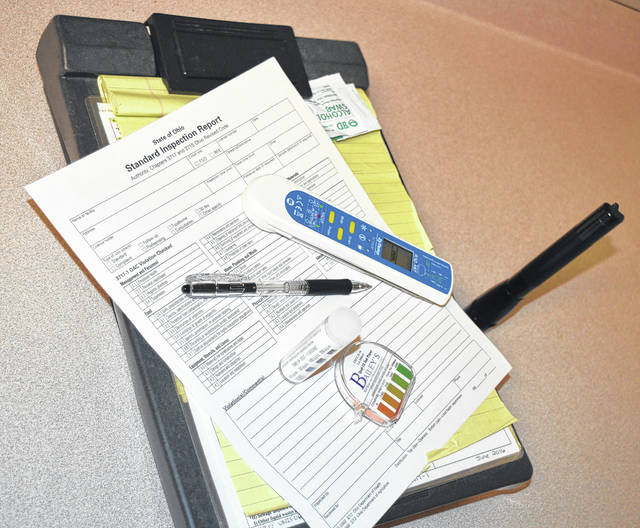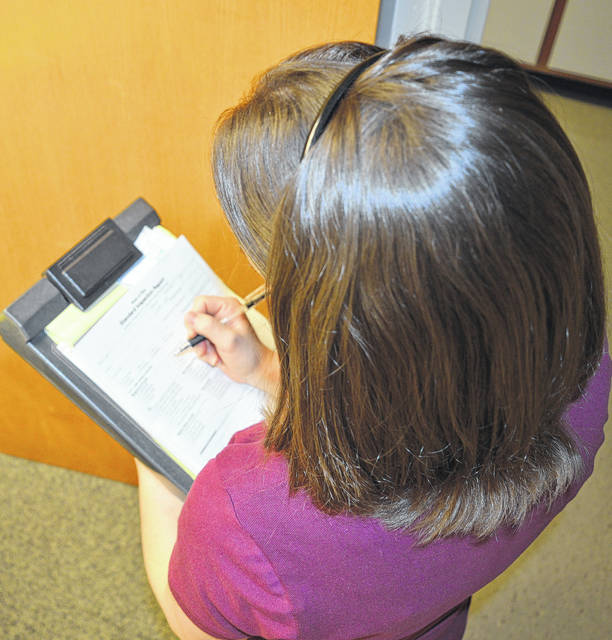

CLINTON COUNTY — Katie Burwinkel drives in a circle around the restaurant before parking her SUV in the nearly empty lot.
The time is pushing 2 p.m. and the lunch rush has quieted.
She dons a baseball cap and pulls her hair through the back, then grabs the tools of her trade, including a food thermometer, a small flashlight and a clipboard.
Katie is an inspector for the Clinton County Health Department, and she’s set to inspect a local eatery.
Becoming an inspector is much more than grabbing a clipboard and looking around a facility.
“My background and training is a Bachelor of Science degree in Environmental Science with a minor in Biology,” she tells the News Journal. “I started working at the Clinton County Health District after graduating college and have been here for 10 years in May.”
She said to become a Registered Sanitarian you must apply to the Ohio State Board of Sanitarian Registration, work in the Environmental Health field for two years, and pass the PES Environmental Health Proficiency Examination.
“After passing the exam every year you must renew your Registered Sanitarian license and complete 18 hours of Board-approved continuing education,” she says.
As Katie enters the restaurant’s main entrance today, she is greeted with a friendly “Hi, Katie!” by a server as well as by a bartender busily preparing for the dinner crowd. Katie smiles and greets them, then asks for the manager.
She says it’s common for her to arrive at a facility and “the manager is welcoming and wants to see what can be improved.”
Other times, “Employees are anxious and you can see them scrambling to try to correct things going on in the facility before I see them,” she says.
While waiting for this manager, she picks up a menu to ensure, among other things, that it’s up-to-date with a consumer advisory statement, plus she sees if there are any new menu items.
She waits for a couple minutes — perhaps the manager is simply busy with a task, or perhaps the staff is hurriedly trying to clean or move something — and then decides to go ahead and make her way back to the kitchen.
An assistant manager greets her with a smile and Katie asks if they have any new equipment or any changes in the food offerings. After a couple more minutes, the restaurant’s manager greets Katie and joins her for the inspection.
Into the kitchen
One of the first things she notices is an employee’s coat and a cell phone charging on a food prep counter. A food service facility must have a dedicated area for such personal items.
It’s a common violation these days; the manager asks the employee to move them to where they belong.
“The thing I like most about my job is helping and educating people,” she says. “I like being able to help people improve their knowledge/business by keeping themselves and the public healthy and safe.
“The thing I dislike about my job is, unfortunately, it involves finding errors or faults in a person’s actions or business practices. Depending on the day or the facility, it can make for a long, frustrating day.”
Katie is always observing every bit of the facility from floor to ceiling as well as employees and their actions — the “wheels” of her knowledge, training and experience are ever-turning. She points out many things the untrained eye wouldn’t notice.
She notices raw beef stored above cooked chicken in the walk-in cooler, and that sauces are kept next to the raw chicken prep area. She points these out to the manager, then scribbles on her notepad.
Some perishable items are missing labels to show either when they were prepared or when they must be used by.
She pulls out her thermometer, carefully wipes it with a tiny disposable sanitized cloth, and sticks it in foods ranging from meats to cheeses and from hot to cold items, cleaning the thermometer’s probe each time.
Cold items need to be at 41 degrees or colder to prevent pathogen growth; she finds that the sour cream is at 50 degrees and the cottage cheese is at 48.
Around the facility
She sees that there’s no “air gap” at the soda fountain — food equipment drain lines must be air gapped/indirectly drained to prevent contamination backing up into the unit. In other words, the drain pipe has to be above the floor drain, with a gap between them.
She sees some water pooling behind the icemaking machine; she points out that there’s a leak in the filter and/or water line.
She spots clean drink glasses on a server station counter; no problems with that — however, just inches away on the floor are several brooms and a vacuum cleaner. Those need to be moved away from clean glasses.
A can of bug spray is stored at the bar, and some spray bottles and a sprayer are missing labels. The manager has an employee correct that right away.
A few food items are missing labels, including sugar and french fry seasoning. The manager corrects those.
Even if violations are immediately corrected, they still are noted.
Some of the paint on the ceiling tiles in the kitchen is peeling. A poster above the salad mix in the prep cooler has lamination peeling. You wouldn’t want any of that in your salad.
Another part of the ceiling has “mold-like” black residues.
Several food containers are cracked and/or damaged. Spoon handles are melted or peeling. Cutting boards are melted or stained.
The warewash machine — the automatic dishwasher/sanitizer — shows no measurable chlorine sanitizer, even though the service company was just there days earlier working on it. A manager makes a call to get them back out that same day.
There’s a little too much grease here, some dust there.
Making the report
After about an hour-and-a half of watching and digging, and asking the manager if there are any questions, Katie sits down in a quiet part of the restaurant and puts her list of violations and comments into a report that will immediately be shared with the restaurant.
She plans a follow-up visit within a month to re-check all the violations to see if they were corrected, and to see if there are any new ones.
And a few days after the inspection, the gist of each report will be in the News Journal — one of the most-read features in the newspaper and online.
Seeing, hearing it all
She says she’s seen a lot in her time as an inspector, including, “roaches, rodents, dirty/smelly facilities, moldy bleach bottles, creative use of equipment, dealing with unruly people, being cussed at, etc.”
But does an inspector have the power to shut down a food service operation?
“Yes and no … I conduct inspections of food service operations and retail food establishments for the Board of Health,” Katie says.
“When or if there is an imminent health hazard, typically there are two actions that can be taken: 1. The FSO (Food Service Operation)/RFE (Retail Food Establishment) voluntarily closes and cooperates with me to correct the health hazard, then re-opens after they pass inspection; or, 2. I contact the Director of Environmental Health and the Health Commissioner and notify them immediately of the health hazard at an FSO/RFE. The Health Commissioner has authority to suspend/revoke a license immediately for an imminent health hazard.”
She says that if a facility has several issues, however it’s not an immediate threat to public health, “Then we work with the laws and due process to suspend or revoke licensing. This could include follow-up inspections, requiring additional food safety training, and Board of Health hearings.”
She says that an imminent health hazard is “a significant threat or danger to health that requires immediate correction or closure of the operation to prevent serious injury.
“Typically, places that I have dealt with will close voluntarily to correct issues. There have been a handful of facilities that have gone through a Health Commissioner meeting or Board of Health hearings for licensing action.”



